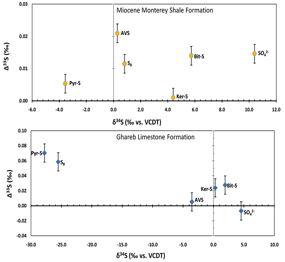58th Annual Report on Research 2013 Under Sponsorship of the ACS Petroleum Research Fund
Reports: ND252623-ND2: Multiple Sulfur Isotope Tests for Sulfur Radical Chemistry During Petroleum Formation and Degradation
Shuhei Ono, PhD, Massachusetts Institute of Technology
Project 1: Sulfur isotope studies of organic and inorganic sulfur species present in petroleum source rocks:
In this research investigation, Harry Oduro (Postdoctoral Fellow at MIT) examined sulfur isotope variations in different sulfur-bearing phases of petroleum source rocks by applying sequential chemical extraction technique developed and previously described in Oduro et al. (2011). We have tested two type source rocks (the Monterey Shale, and Ghareb Limestone formations), and successfully extracted various sulfur-bearing fractions, including acid volatile sulfur (FeS and other metal sulfide), pyrite sulfur (FeS2), elemental sulfur (S8), organic sulfur pools (bitumen and kerogen sulfur), and sulfate. They show δ34S variation up to 35 ä. We found that the isotope systematics among different phases vary between two formations, which may reflect different sources of sulfur or different diagenetic processes in these petroleum source rocks (attached figure). There are small but measurable S-33 signals that might be used to provide further new insights about microbial sulfate reduction and sediment diagenetic processes. We plan to add another source rock formation, as well as to isolate thiophenic sulfur for isotope ratio analysis during the year 2 of the project.
Project 2: Mass-dependent and mass-anomalous sulfur isotope fractionation during thermal decomposition of sulfur bearing organic compounds.
This work is a follow up of Oduro et al. (2011) and Watanabe et al. (2010) of the generation of mass-anomalous isotope signal, in particular, S-33 during thermochemical reaction involving sulfur and amino acids. For first set of experiments, common sulfur containing amino acids (e.g., cysteine, methionine, taurine, and glutathionine) were thermally decomposed under vacuum in glass reactors, and sulfur-bearing phases (organic-S, H2S and polysulfide) were isolated for sulfur isotope analysis. They yielded mass-dependent fractionation up to 15ä between the AVS and the residual organic-S fractions. This work has also involved collaborations with Dr. Weifu Guo at WHOI, who is performing an empirical isotopic fractionation model and confirmed larger isotopic mass dependent fractionations of taurine up to 33ä with relatively similar fractionations for cysteine, methionine, and glutathionine. Thermal decomposition of taurine produced relatively large isotope effect, which is consistent with estimated zero-point energy shifts for sulfonic acid (R-SO2OH) compared to thiol (R-SH) and thiyl (R-S-CH3) functional groups of cysteine and methionine, respectively. Additional experiments are planned to characterize the experimental products using GC and NMR to understand the mechanism responsible for producing the mass dependent signatures.
Second sets of experiments, several model sulfur compounds with 1) an aliphatic S-S (e.g., diphenyl disulhide), 2) aromatic thiophenic sulfur (Trithiane), and thiol (cysteine) functional groups were tested for sulfur isotope fractionation during thermal decomposition. Among these, aromatic trithiane produced anomalous S-33 up 1.3ä, indicating thermal decomposition through radical chemistry, producing magnetic isotope effect. Additional set of experiments is planned to investigate if similar reactions can occur during petroleum formation and anomalous S-33 signal can be preserved.
Figure: Multiple suflur isotope compositions for various sulfur-bearing phases in petroleum source rocks
Copyright © 2014 American Chemical Society












